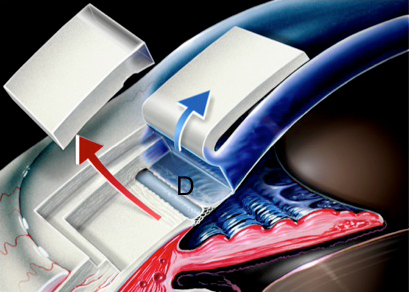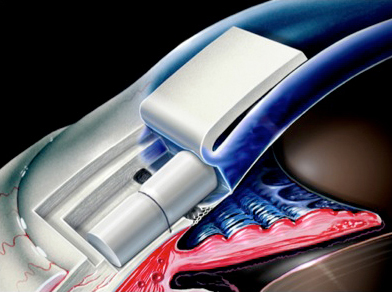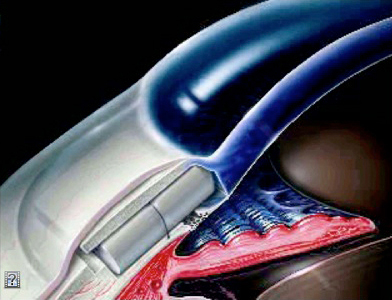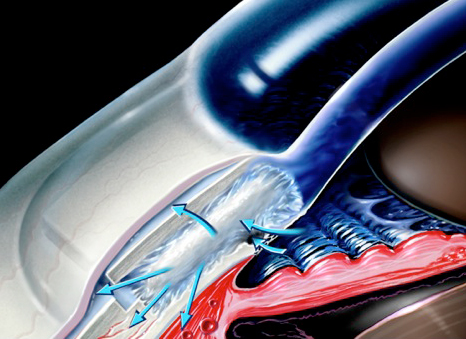AquaFlow: Cataracts and Glaucoma – James S. Lewis, MD
Serving Northeast Philadelphia, King of Prussia, Montgomery County, Conshohocken, Philadelphia, Phoenixville and the Main Line
AquaFlow™ or more generally, non-penetrating deep sclerectomy (NPDS) combined with cataract surgery is an excellent option for patients with cataracts and glaucoma.
Some Philadelphia / Bucks County cataract patients are content to continue using their glaucoma medications following cataract surgery. Unfortunately, the cost of drops and co-payments continue to rise. Furthermore glaucoma medications have systemic side effects and after years patients can develop tachyphylaxis (less effective over time) and allergy to these medications. Also, immediate post-operative pressure spikes in cataract patients with glaucoma can have significant unwanted consequences. These factor motivate skilled cataract surgeons to combine cataract surgery with minimally invasive glaucoma surgery (MIGS). Similarly, many cataracts and glaucoma patients prefer their surgeon address both conditions at the time for surgery. In some cases a combined surgical procedure is absolutely necessary to maintain ocular health.
Non-penetrating deep sclerectomy (NPDS) combined with cataract surgery is an excellent choice for patients with cataracts and glaucoma. Alternative procedures like trabeculectomy, mitomycin trabeculectomy, Express Shunt, Ahmed Value, Molteno Tube and other setons significantly delay visual rehabilitation after cataract surgery. Dr. James Lewis has been performing combined cataract and NPDS for almost a decade. In particular, he uses the AquaFlow implant to maintain excellent glaucoma pressure control after cataract surgery. Visual recovering is almost immediate and comfort is maintained. Unlike full thickness glaucoma procedures, no excessive pressure fluctuations, flat chambers, choroidals, choroidals hemorrhages, macular edema or retinal hypotony occur. Cataract extraction and Aquaflow Surgery as a combined procedure takes less than 30 minutes, is performed under local anesthesia, uses no sutures, has no foreign body sensation and does not involve cosmetic abnormalities resulting from removal of iris tissue. (Almost all other glaucoma procedures involve removing small portions of the iris often distorting the size and shape of the pupil.)
Dr. Lewis has performed thousands of these procedures and is the most experienced Aquaflow Surgeon in the United States.
For patients with less aggressive glaucoma, Dr. Lewis may choose to combine cataract surgery with iStent.
[su_row]
[su_column size=”1/2″]
- Glaucoma Introduction
- Glaucoma Description
- How Fluid Circulates in the Eye
- Glaucoma Cause
[/su_column]
[su_column size=”1/2″]
- Glaucoma Risk
- Ocular Hypertension
- Open-Angle Glaucoma
- Narrow- Angle Glaucoma
[/su_column]
[/su_row]
Nearly one out of six patients of cataract age have some form of glaucoma. Sometimes this has not been diagnosed because glaucoma is a silent condition.
The region marked A is the cataract. Excess pressure causing glaucoma is produced at B. Their proximity help explain why cataracts and glaucoma frequently co-exist. Schlemm’s canal is the exit route for excess aqueous humor C and is the focus of the Aquaflow procedure.
The AquaFlow Procedure
Localize Schlemm’s Canal

Immediately after the cataract is removed and the intraocular lens implanted Dr. Lewis exposes Schlemm’s canal (D) deep in the stroma. Notice the entire surgery takes place without actually entering the eye consequently the name, non-penetrating deep sclerectomy.
Unroofing Schlemm’s Canal

Excess aqueous humor fails to flow though Schleem’s canal in patients with glaucoma. For this reason the canal is opened allowing more fluid to pass from the anterior chamber of the eye, through the trabecular meshwork and back into the normal ocular channels.


Inserting the AquaFlow Device
The AquaFlow shunt acts as a stent allowing fluid to flow into a tiny natural reservoir hidden below the ocular surface behind the lid. There are no scars or filtering blebs to call attention to this very effective surgery.

The AquaFlow Device Dissolves in 9 months
The AquaFlow is made of collagen and dissolves after it has created a new pathway for the excess intraocular pressure. Most of our Philadelphia cataract and glaucoma patients maintain excellent intraocular pressure control following AquaFlow insertion. Furthermore, many of them are able to achieve this without any glaucoma medications.
In addition to helping cataracts patients with glaucoma, Dr. Lewis is also experienced in treating cataract patients suffering from astigmatism and dry eye. Dr. Lewis is one of the more experienced cataracts surgeons in the United States, and he has been recognized as a foremost Philadelphia multifocal IOL (ReSTOR, Tecnis Multifocal and ReZoom), astigmatism-correcting IOLs (Crystalens Toric {Trulign} and Alcon Toric), and accommodating IOLs (Crystalens AO) provider.
